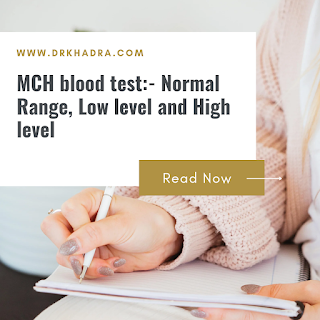Introduction
MCH, or Mean Corpuscular Hemoglobin, is a measurement taken during a blood test to show how much hemoglobin is in each red blood cell.
Hemoglobin is a protein in red blood cells that carries oxygen throughout the body. It is calculated by dividing the total hemoglobin by the number of red blood cells, giving an average amount of hemoglobin in each cell.
This helps diagnose and monitor certain types of anemia, a condition where there's not enough hemoglobin or red blood cells in the blood. Its levels provide insights into red blood cell size and hemoglobin content, helping doctors figure out the cause of anemia
Purpose
The MCH test is used to help diagnose and monitor anemia, a condition in which there are not enough healthy red blood cells or the red blood cells do not have enough hemoglobin. Anemia can cause a variety of symptoms, including fatigue, weakness, shortness of breath, and pale skin.
The its test can also be used to help diagnose other blood disorders, such as:
●Iron deficiency anemia: This is the most common type of anemia, and it is caused by a lack of iron in the body.
●Vitamin deficiency anemia: This type of anemia is caused by a deficiency of vitamins B12 or folate.
●Sickle cell anemia: This is a genetic disorder that causes red blood cells to be abnormally shaped.
●Thalassemia: This is another genetic disorder that affects the production of hemoglobin
Procedure
A. The MCH test is typically performed as part of a complete blood count (CBC)
B. A blood sample is drawn from a vein in the arm and sent to a laboratory for analysis
Normal Range
The usual MCH levels range is usually between 27 and 33 picograms per cell. However, this range might differ a bit based on the lab and reference values.
Results within this range are seen as normal for a person's health.
Clinical implications of abnormal MCH:
Microcytosis:
●Iron deficiency anemia is the most prevalent cause of microcytosis.
●It is caused by a lack of iron in the body, which is needed to make hemoglobin.
●Thalassemia is an inherited condition that disrupts the synthesis of hemoglobin.
●Lead poisoning is caused by exposure to lead, which can damage red blood cells.
Macrocytosis:
●Vitamin B12 deficiency is caused by a lack of vitamin B12, which is needed for DNA synthesis.
●Folate deficiency is caused by a lack of folate, which is another B vitamin that is needed for DNA synthesis.
●Liver disease can cause macrocytosis because the liver is responsible for producing bile, which is needed for the absorption of vitamin B12.
Low Level
A low MCH (mean corpuscular hemoglobin) blood test result means that the average hemoglobin amount in your red blood cells is below the normal range. Hemoglobin, which carries oxygen in your body, is reduced.
This could indicate conditions like not having enough iron for hemoglobin production (iron deficiency anemia) due to a poor diet, blood loss, or absorption issues. Additionally, chronic illnesses like kidney disease or autoimmune disorders might also impact its levels.
Low Mean Corpuscular Hemoglobin (MCH) levels might result in symptoms like
• fatigue
• paleness
• weakness
• and a reduced ability to deliver oxygen to the body's tissues
High level
If your MCH blood test shows high results, it means the average hemoglobin amount in your red blood cells is greater than the usual range.
This might point to conditions like larger red blood cells due to macrocytic anemia, often linked to vitamin deficiencies, or liver issues. Excessive alcohol or specific drugs might also impact its levels.
High mean corpuscular hemoglobin levels could indicate potential health issues. Common symptoms of elevated it include fatigue, pale skin, and shortness of breath. If you're experiencing these symptoms, it's advisable to consult a healthcare professional for proper evaluation and guidance.
Factors Affecting it Results
Limitations
The MCH test is a common blood test that measures the average amount of hemoglobin in a red blood cell. Hemoglobin, a crucial component of red blood cells, plays a critical role in transporting oxygen from the lungs to the body's cells.
An abnormal its level can be a sign of anemia, but it can also be caused by other conditions:-
● Does not provide specific information about the cause of anemia: It can be caused by a variety of factors, including iron deficiency, vitamin deficiency, bone marrow disorders, and blood loss. It alone cannot determine the cause of anemia, and further testing may be needed.
● Affected by red blood cell size: The MCH test is calculated by dividing the hemoglobin level by the red blood cell count. This means that its level can be affected by the size of the red blood cells. For example, people with macrocytic anemia (large red blood cells) will have a low MCH level, even if their hemoglobin level is normal.
● Not a standalone test: The test is usually interpreted in conjunction with other blood tests, such as the MCV (mean corpuscular volume) and MCHC (mean corpuscular hemoglobin concentration). These tests can help to provide more information about the size and color of the red blood cells, which can help to narrow down the cause of anemia.
In addition to the above limitations, the its test can also be affected by:
•Laboratory factors: The accuracy of its test can be affected by factors such as the quality of the blood sample and the type of analyzer used.
•Medication: Certain medications can interfere with its test.
•Other medical conditions: Certain medical conditions, such as liver disease and kidney disease, can affect its test.
Overall, the MCH test is a useful tool for screening for anemia, but it is important to remember that it is not a standalone test and should be interpreted in conjunction with other blood tests and clinical findings.


Post a Comment